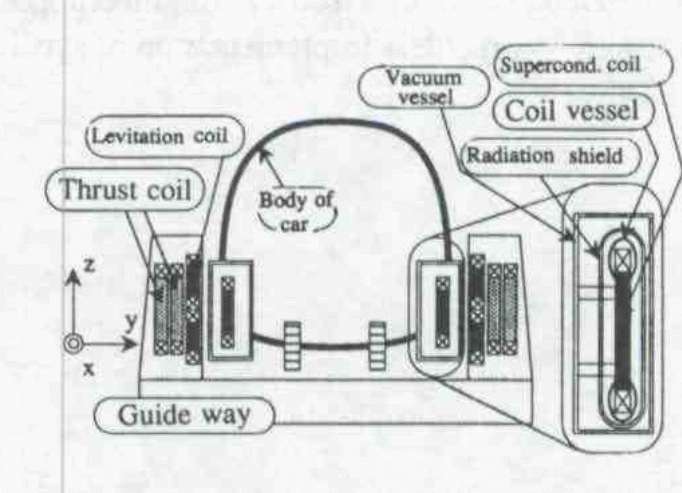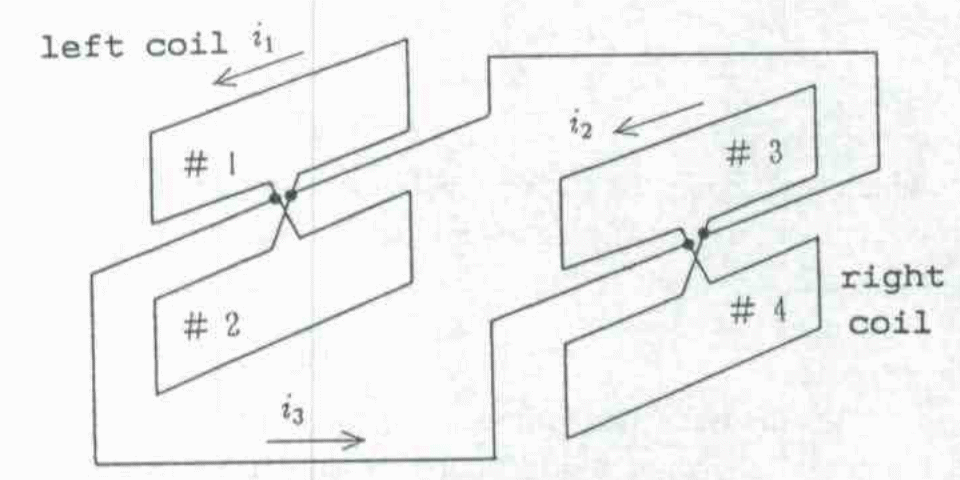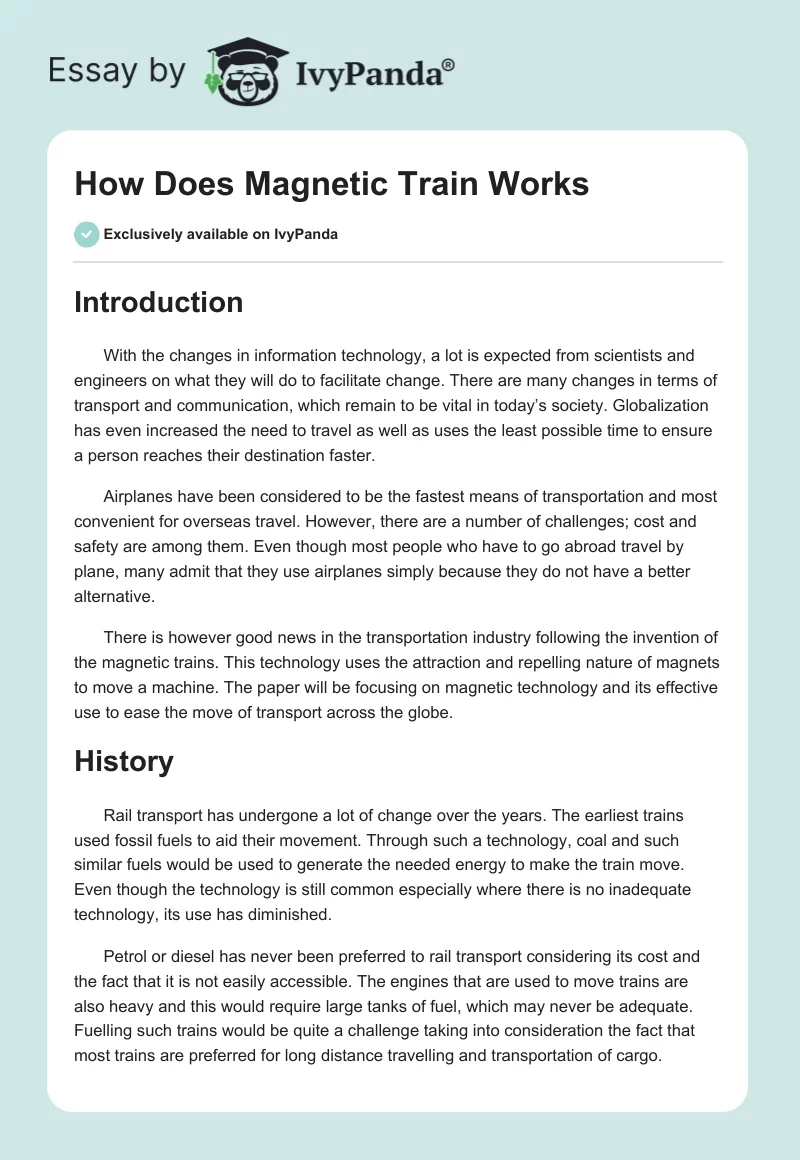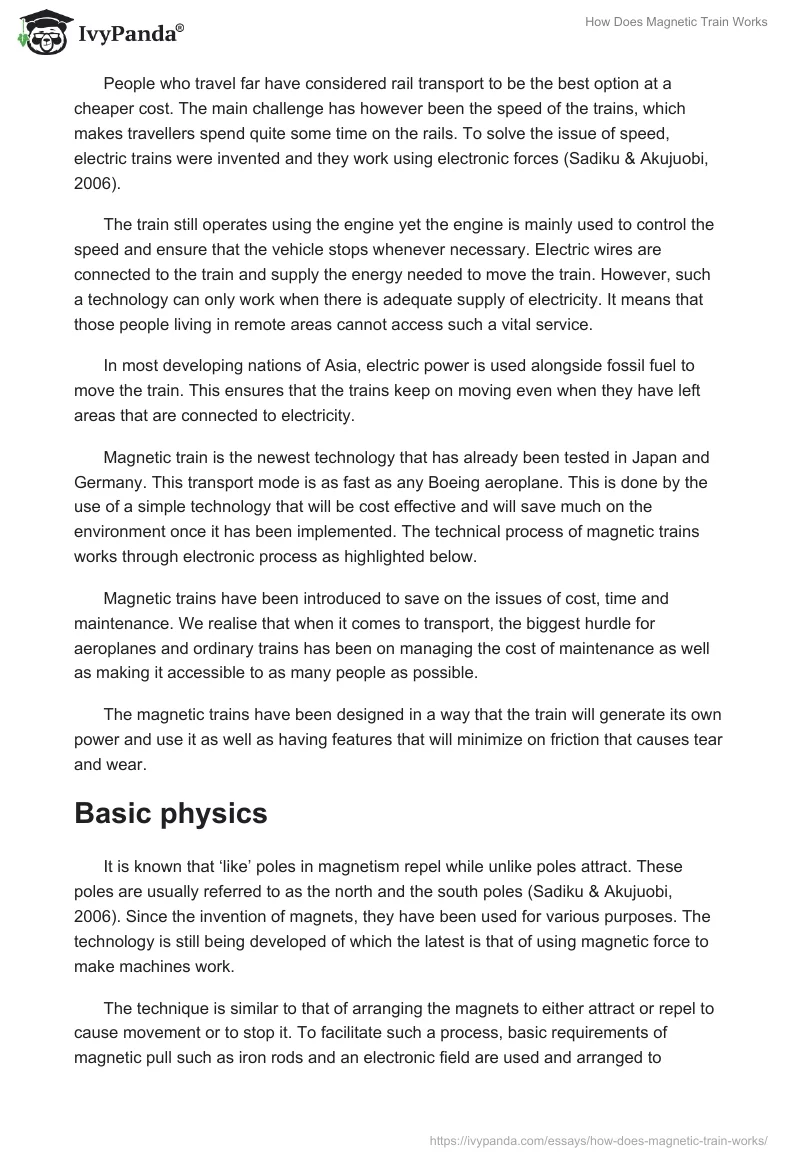Introduction
With the changes in information technology, a lot is expected from scientists and engineers on what they will do to facilitate change. There are many changes in terms of transport and communication, which remain to be vital in today’s society. Globalization has even increased the need to travel as well as uses the least possible time to ensure a person reaches their destination faster.
Airplanes have been considered to be the fastest means of transportation and most convenient for overseas travel. However, there are a number of challenges; cost and safety are among them. Even though most people who have to go abroad travel by plane, many admit that they use airplanes simply because they do not have a better alternative.
There is however good news in the transportation industry following the invention of the magnetic trains. This technology uses the attraction and repelling nature of magnets to move a machine. The paper will be focusing on magnetic technology and its effective use to ease the move of transport across the globe.
History
Rail transport has undergone a lot of change over the years. The earliest trains used fossil fuels to aid their movement. Through such a technology, coal and such similar fuels would be used to generate the needed energy to make the train move. Even though the technology is still common especially where there is no inadequate technology, its use has diminished.
Petrol or diesel has never been preferred to rail transport considering its cost and the fact that it is not easily accessible. The engines that are used to move trains are also heavy and this would require large tanks of fuel, which may never be adequate. Fuelling such trains would be quite a challenge taking into consideration the fact that most trains are preferred for long distance travelling and transportation of cargo.
People who travel far have considered rail transport to be the best option at a cheaper cost. The main challenge has however been the speed of the trains, which makes travellers spend quite some time on the rails. To solve the issue of speed, electric trains were invented and they work using electronic forces (Sadiku & Akujuobi, 2006).
The train still operates using the engine yet the engine is mainly used to control the speed and ensure that the vehicle stops whenever necessary. Electric wires are connected to the train and supply the energy needed to move the train. However, such a technology can only work when there is adequate supply of electricity. It means that those people living in remote areas cannot access such a vital service.
In most developing nations of Asia, electric power is used alongside fossil fuel to move the train. This ensures that the trains keep on moving even when they have left areas that are connected to electricity.
Magnetic train is the newest technology that has already been tested in Japan and Germany. This transport mode is as fast as any Boeing aeroplane. This is done by the use of a simple technology that will be cost effective and will save much on the environment once it has been implemented. The technical process of magnetic trains works through electronic process as highlighted below.
Magnetic trains have been introduced to save on the issues of cost, time and maintenance. We realise that when it comes to transport, the biggest hurdle for aeroplanes and ordinary trains has been on managing the cost of maintenance as well as making it accessible to as many people as possible.
The magnetic trains have been designed in a way that the train will generate its own power and use it as well as having features that will minimize on friction that causes tear and wear.
Basic physics
It is known that ‘like’ poles in magnetism repel while unlike poles attract. These poles are usually referred to as the north and the south poles (Sadiku & Akujuobi, 2006). Since the invention of magnets, they have been used for various purposes. The technology is still being developed of which the latest is that of using magnetic force to make machines work.
The technique is similar to that of arranging the magnets to either attract or repel to cause movement or to stop it. To facilitate such a process, basic requirements of magnetic pull such as iron rods and an electronic field are used and arranged to facilitate the movement. The gravitational force, which is also responsible for the force, is also used to set up the apparatus.
It is known that magnetic force is attracted to like poles whiles it is being repelled from opposite poles (Shibata, Maki, Saito and Kobayashi 1993). Magnetic trains are hence designed to ensure that magnetic poles attract and repel when it is needed.
Superconducting magnets have become crucial in the entire procedure of magnetic trains as they conduct larger amounts of energy required to facilitate movement of the trains (Shibata, Maki, Saito and Kobayashi 1993, p.112). The sidewalls of the rails mount the levitate coils in the maglev rail system, which is used in magnetic trains.
Adequate magnetic force has to be generated to facilitate this. The eddy or Foucault currents (currents produced by the change of magnetic filed in the conductor) required are generated by harmonics at the surface where the superconducting magnets have been positioned (Shibata et al 1993, p. 113).
With the static magnetic field and the eddy currents being produced, this will yield a powerful force that will result in the evaporation of helium liquid. As the forces interact, there is generation of amplitude and a continuous magnetic flux that will subsequently make the train move. Below is a diagram that clearly illustrates the process of a magnetically levitated train.
Figure 1

Source: (Shibata et al 1993, p. 112)
The above represented scheme clearly shows that the process is managed electronically with the thrust coil, levitation coil, the vessel coil and the superconductor coil. The fundamental flux produced by the ground coils and harmonic flux provides guidance and the levitation of the magnetic train (Shibata et al 1993, p. 115).
Similarly, Fujiwara and Fujimoto (1993, pg 124) also came up with a working principle of a magnetic train that uses both the levitation and the guiding scheme (Fujiwara & Fujimoto 1993, p.124). The figure below shows how the left and the right coils are connected to each other in a parallel way.
Figure 2

Source: Fujiwara & Fujimoto (1993, p.124)
There is a great similarity in how the two technologies work apart from some slight modifications. For instance, the magnetic drag force is significantly reduced in the EDS maglev vehicle through adjustments. Here, the two rectangular unit coils make up for the levitation coil.
The main purpose of the rectangular unit coils is to prevent the induction of electric current on the levitation coil. This, hence, implies that the levitation and guidance functions are performed by the left and right coils consistently (Fujiwara & Fujimoto 1993, p.128).
Due to high amount of heat that is usually produced during this process, the guide way is fitted with super coolers that regulate the amount of heat. This is an automated process that happens once the train senses a lot of heat production. This, therefore, ensures that the train is safe from overheating and eventually causing fires.
The magnetic process is also designed in a way that the train may be slowed down or accelerated once the need arises. This is the main purpose of the engine like feature that is fitted in the train. The EDS system operates almost like a train as the maglev trains rolls on tires that are made of rubber (Shibata et al 1993, p. 117). The rolling will happen until the train gathers adequate momentum of speed of about 62 mph (100 kph).
This EDS system was invented in Germany by the use of such technology. The wheels are of great advantage especially when power fails. The train can hence held itself on wheels minimizing on any form of accident. The indutracks are designed in two different forms to cater for high and low speed.
Indutrack 1 has been designed to handle high speed while indutrack 2 has been designed to handle slower speed for slightly shorter distances. The track of the magnetic trains is composed of electrically short-circuits that have been insulated using wires.
Conclusion
After successful trials in Japan and Germany, the magnetic train will be the modern form of transport that will relive many travellers. It is a revolution that is still undergoing extensive research as well as improvements that will make it better. It has been considered that once the technology is fully exploited, it will be able to transport passengers across the world in just a few hours.
The fastest maglev is faster that a normal Boeing aeroplane and cost effective. The main challenge is to construct the long guide ways fitted with the magnetic coils. Apart from the fact that they are economical on cost, they are also environmental friendly considering the fact that they are smoke free and do not produce much noise.
The space used to construct such runways is not much and can either be done underground or elevated in the air. This implies that other activities can still be happening in those places where the guide ways have been constructed.
References
Fujiwara, S & Fujimoto, T 1993, ‘Characteristics of Combined Levitation and Guidance EDS Maglev System’, Electrical Engineering in Japan, vol. 113. no. 3.
Sadiku, M &Akujuobi, C 2006, ‘Magnetic levitation’, IEEE Potentials. vol.25. no.2.
Shibata, M., Maki, N., Saito, T & Kobayashi, T 1993, ‘Levitation Coil length Optimization of a magnetically Levitation Train’, Electrical Engineering in Japan, vol. 113. no. 2.


